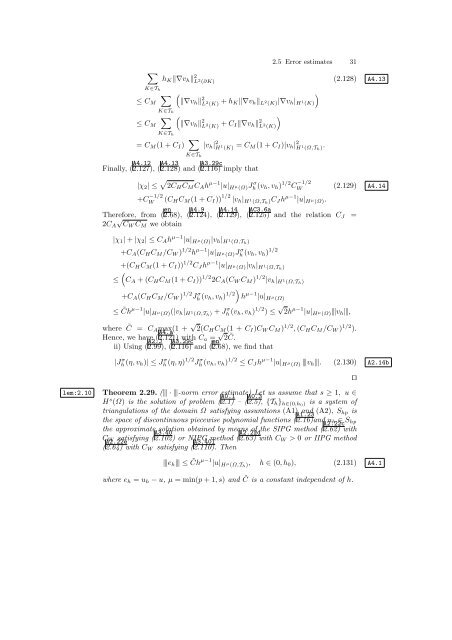2 DGM for elliptic problems
2 DGM for elliptic problems
2 DGM for elliptic problems
You also want an ePaper? Increase the reach of your titles
YUMPU automatically turns print PDFs into web optimized ePapers that Google loves.
∑<br />
2.5 Error estimates 31<br />
h K ‖∇v h ‖ 2 L 2 (∂K) (2.128) A4.13<br />
K∈T h<br />
∑ (<br />
)<br />
≤ C M ‖∇v h ‖ 2 L 2 (K) + h K‖∇v h ‖ L 2 (K)|∇v h | H 1 (K)<br />
K∈T h<br />
∑ (<br />
)<br />
≤ C M ‖∇v h ‖ 2 L 2 (K) + C I‖∇v h ‖ 2 L 2 (K)<br />
K∈T h<br />
= C M (1 + C I ) ∑<br />
|v h | 2 H 1 (K) = C M(1 + C I )|v h | 2 H 1 (Ω,T h ) .<br />
K∈T h<br />
Finally, ( A4.12 2.127), ( A4.13 2.128) and ( A3.29c 2.116) imply that<br />
|χ 2 | ≤ √ 2C H C M C A h µ−1 |u| Hµ (Ω)J σ h(v h ,v h ) 1/2 C −1/2<br />
W<br />
(2.129) A4.14<br />
+C −1/2<br />
W<br />
(C HC M (1 + C I )) 1/2 |v h | H 1 (Ω,T h )C J h µ−1 |u| H µ (Ω).<br />
There<strong>for</strong>e, from ( 2.68), en ( 2.124), A4.9 ( 2.129), A4.14 ( 2.125) AC3.6a<br />
√<br />
and the relation C J =<br />
2C A CW C M we obtain<br />
|χ 1 | + |χ 2 | ≤ C A h µ−1 |u| H µ (Ω)|v h | H 1 (Ω,T h )<br />
+C A (C H C M /C W ) 1/2 h µ−1 |u| Hµ (Ω)J σ h(v h ,v h ) 1/2<br />
+(C H C M (1 + C I )) 1/2 C J h µ−1 |u| H µ (Ω)|v h | H 1 (Ω,T h )<br />
(<br />
≤ C A + (C H C M (1 + C I )) 1/2 2C A (C W C M ) 1/2 |v h | H1 (Ω,T h )<br />
+C A (C H C M /C W ) 1/2 J σ h (v h ,v h ) 1/2) h µ−1 |u| H µ (Ω)<br />
≤ ˜Ch µ−1 |u| Hµ (Ω)(|v h | H1 (Ω,T h ) + J σ h(v h ,v h ) 1/2 ) ≤ √ 2h µ−1 |u| Hµ (Ω)|||v h |||,<br />
where ˜C = C A max(1 + √ 2(C H C M (1 + C I )C W C M ) 1/2 ,(C H C M /C W ) 1/2 ).<br />
Hence, we have ( 2.121) A4.a with C a = √ 2 ˜C.<br />
ii) Using ( 2.99), A2.J ( 2.116) A3.29c and ( 2.68), en we find that<br />
|J σ h (η,v h )| ≤ J σ h (η,η) 1/2 J σ h(v h ,v h ) 1/2 ≤ C J h µ−1 |u| H µ (Ω) |||v h |||. (2.130) A2.14b<br />
⊓⊔<br />
lem:2.10<br />
Theorem 2.29. (||| · |||-norm error estimate) Let us assume that s ≥ 1, u ∈<br />
H s (Ω) is the solution of problem ( 2.1) A0.1 – ( 2.5), A0.3 {T h } h∈(0,h0) is a system of<br />
triangulations of the domain Ω satisfying assumtions (A1) and (A2), S hp is<br />
the space of discontinuous piecewise polynomial functions ( 2.16)and A1.23 u h ∈ S hp<br />
the approximate solution obtained by means of the SIPG method ( 2.62) A2.22c with<br />
C W satisfying ( 2.102) A3.40 or NIPG method ( 2.63) A2.22d with C W > 0 or IIPG method<br />
( 2.64) A2.22e with C W satisfying ( 2.110). A3.40I Then<br />
|||e h ||| ≤ ˜Ch µ−1 |u| Hµ (Ω,T h ), h ∈ (0,h 0 ), (2.131) A4.1<br />
where e h = u h − u, µ = min(p + 1,s) and ˜C is a constant independent of h.
















